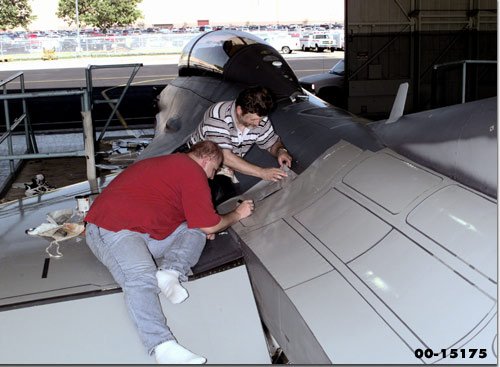Lockheed Martin JSF team evaluates 'Paintless' film
October 11, 2000
An F-16 fully covered with a new-generation "paintless" film has made a series of successful test flights - - including one at almost twice the speed of sound -- validating the use of appliqués instead of paint on advanced aircraft such as the Lockheed Martin Joint Strike Fighter (JSF).
Aircraft appliqués consist of paint-replacement adhesive films designed to bring savings in production costs, support requirements, disposal costs and aircraft weight. They also offer significant environmental advantages, since commercial and military painting operations are a significant source of hazardous-material emissions.
"On the Joint Strike Fighter program, appliqués could save $3 billion in life-cycle costs compared to conventional paint processes, according to preliminary estimates for 3000 aircraft," said Frank J. Cappuccio, VP and program manager for the Lockheed Martin JSF. "This technology maturation is typical of the program's concept demonstration phase strategy of stepping up to the challenges in the concept phase when the developmental costs are lower, since we do not have a 'standing army' of people on the program."
The F-16 with the new-generation film made its successful first flight from Lockheed Martin Aeronautics Company - Fort Worth, where team members applied the film. On a subsequent flight the aircraft attained a top speed of Mach 1.8 -- the highest speed ever reached in an appliqué flight test.
Lockheed Martin is also evaluating the potential benefits of applying paintless coating technologies to current military. In addition to the F-16, the company has been applying and flight-testing appliqués during the past five years on S-3, C-130, F/A-18 and DC 9-31 aircraft.
In the most recent application to the F-16, technicians applied approximately 1,300 square feet of the film to the aircraft. This represents virtually the entire paintable external surface, including the fuselage in front of the inlet.
Lockheed Martin performed the appliqué project as a company-funded, JSF producibility maturation demonstration. The company initially developed appliqué technologies in cooperation with 3M, the U.S. Air Force and Navy, and commercial airlines. The cooperative work resulted in three 1998 industry awards: Flight International's Aviation Industry Award, Aerospace Engineering's Top 15 Technology Innovators and Aviation Week & Space Technology's Technology Innovation Award.
Lockheed Martin produces the world's most advanced and successful fighter aircraft, including the F-22, F-117 and F-16. The company, in partnership with Northrop Grumman and BAE SYSTEMS, is in competition to build the JSF for the United States and Great Britain. Government selection of a single contractor for the Engineering and Manufacturing Development phase is set for 2001.
Edited by Mark Drukenbrod
Managing Editor, Adhesives and Sealants Online and Paint and Coatings Online
interesting that photo was soon removed from LM site

